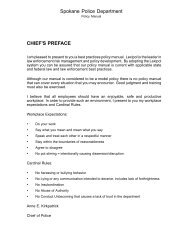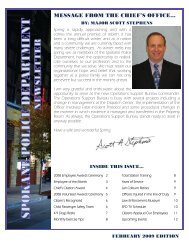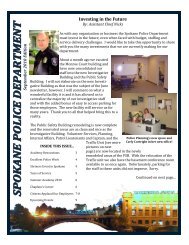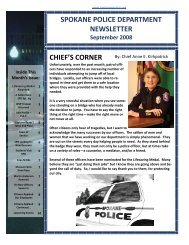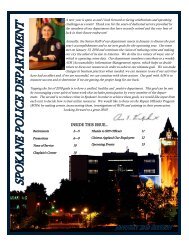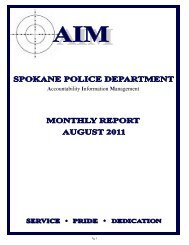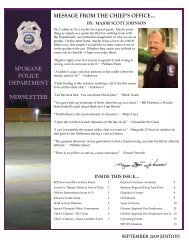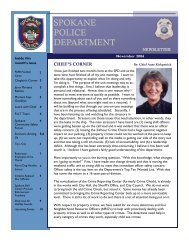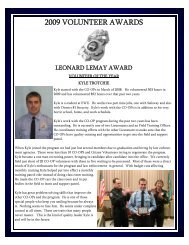DRAFT REPORT OF THE CITY OF SPOKANE USE ... - Samuel Walker
DRAFT REPORT OF THE CITY OF SPOKANE USE ... - Samuel Walker
DRAFT REPORT OF THE CITY OF SPOKANE USE ... - Samuel Walker
Create successful ePaper yourself
Turn your PDF publications into a flip-book with our unique Google optimized e-Paper software.
Mr. Earl F. Martin<br />
RE: <strong>REPORT</strong> TO <strong>USE</strong> <strong>OF</strong> FORCE COMMISSION<br />
December 3, 2012<br />
Page 14<br />
supporting materials for the lecture are not up-to-date with recent case law, in particular with regard<br />
to use of force cases. Thus, the use of force report writing program would benefit from an on-going<br />
review by legal counsel for the department familiar with recent developments in case law and use<br />
of force concepts. Additionally, it was suggested that an emphasis be placed on the "Graham"<br />
factors and officer/subject factors in evaluating the reports and that supervisors be tested on report<br />
review and approval.<br />
<strong>USE</strong> <strong>OF</strong> FORCE - ELECTRONIC CONTROL DEVICES<br />
Detective Randy Lesser is the designated Electronic Control Device (ECD) instructor for<br />
Spokane Police Department. Det. Lesser is also the SWAT Team Leader for the department. Det.<br />
Lesser was originally certified as a TASER ECD instructor in 2002 and has subsequently been<br />
re-certified every 2 years. He has not requested nor applied to be elevated to a Master Instructor<br />
level which would qualify him to certify other ECD instructors and to do re-certifications for SPD<br />
himself.<br />
Det. Lesser explained that SPD personnel receive a 4-hour block of training on ECDs. SPD<br />
does not do re-certification annually as recommended by TASER International. Det. Lesser<br />
indicated that this is a result of a cost issue based on a per cartridge cost estimated at $26. According<br />
to Det. Lesser, the last in-service ECD training for SPD personnel was in 2010 and consisted of 1<br />
hour of training (see "Taser Updates: In-Service 2010" attached hereto as Exhibit "F") which<br />
focused on ECD maintenance issues, ECD operation issues, and the #1 TASER Application Rule,<br />
as the document refers to it, summarized as follows:<br />
"Minimize the number of taser applications in any situation. If possible, have an<br />
arrest team and apprehension plan in place prior to tasering the suspect. The suspect<br />
is only incapacitated while the electricity is on. This is the time to apprehend and<br />
cuff the suspect if possible. The lack of an apprehension plan often leads to repeated<br />
taser applications, which can increase the length of the physical struggle and lead to<br />
the suspect exhibiting symptoms of exhaustion, distress or agitated/excited delirium."<br />
In discussing the issue of annual or bi-annual ECD training, Det. Lesser provided a<br />
document detailing the comprehensive nature of the subject areas covered in the 2010 ECD update.<br />
Det. Lesser explained that annual hands-on training with the ECDs has previously been deemed<br />
unnecessary because targeting with an ECD is perceived as simply a matter of using the built in ECD<br />
laser sighting system. Additionally, as mentioned above, he pointed out that having every officer<br />
discharge one or more ECD cartridges a year solely for training purposes is cost prohibitive.



